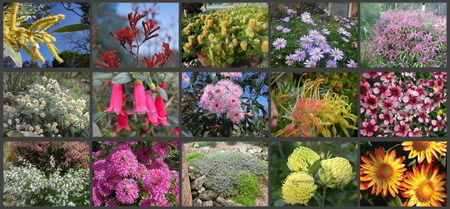
Edible gardens by Adam McCall
Doing your own landscape design can be quite easy if you stick to a few simple principles. It is also rewarding. Just think - once you finish your garden how good you will feel living in it. Something you created yourself.
Good landscape design also adds value to your home where bad landscape design can lose you money. The first step to take is to create a plan for yourself, put your landscape design down on paper.
If you keep it simple, and don't be afraid to get advice, start building your landscape design element by element. This way the project will not be so daunting. It is also good for building confidence in your abilities, especially if you are new to do it yourself landscape design.
Keep it simple (the KISS principle)
Keeping it simple is the first principle of design and anything creative. If you have no experience in landscape design, the simpler you keep it in the beginning the easier you will find it to create your finished garden.
When choosing your plants pick a couple of colors and repeat the color scheme throughout the garden. Even use variations of the colors. If you want to use rocks and stones, try and keep them a similar size.
Keep your theme specific and simple. You can add more to it as you go. Keeping it simple lets you achieve in small steps and see your landscape grow gradually.
What colors will work?
Color brings your garden alive; gives it dimension. Blues, greens, pastels and cool colors make objects appear further away. Oranges, yellows and reds make things appear closer.
White, black and gray are neutral and should be used as backdrops to the colors in front of them. Use light colored, fine textured plants behind dark course textured plants to create added depth to your landscape design.
Good use of color creates depth, interest and movement to your garden and draws attention to different focal points.
Creating lines and proportion through your garden
Creating lines and proportion in your garden is really quite simple. Lines are structural - the way you move through your property, how flower beds and pathways are used. Curving lines create a natural, flowing effect and straight lines are cold and direct.
Proportion directly relates to the size of your elements; and how they affect or relate to each other. When you create your landscape design, you can deliberately plan your proportions to create the atmosphere you want.
Think of it like this. You would not use a massive statue in the middle of a small courtyard garden nor would you put a small water feature in the middle of a big open space. Both would look ridiculous. You can have a statue in your courtyard garden but don't make it too big and the centre is probably not the most convenient place. The point is to scale your elements so they fit together and don't look out of place in your landscape design.
Make sure you consider the plants you want to use so they are in proportion with the rest of your garden.
Is there natural transition?
Forming natural transitions throughout your landscape design gives your garden a natural flow. Each area flows into the other with gradual changes.
Transition is creating a natural flow of textures, colors, forms and sizes from element to element. A transition can be as simple as following a meandering path that leads to a new element of your design - maybe an outdoor eating area.
Transitions create illusions in your garden. Planting tall plants behind shorter plants creates the illusion of space and depth to make your garden look bigger than it really is.
Balancing your visual effects
There are two types of balance in landscape design - symmetrical and asymmetrical. It is all about balance for visual effect.
Symmetrical balance is where everything is roughly equal or mirror images become part of your landscape design. For example, imagine this, divide your garden in half and visualize the shapes, colors, plants, plant heights, and theme reflected in the other half to give it balance.
Asymmetrical balance is more complex. It is very free and creative and often has separate or different themes; with randomly placed shapes and features. But, for natural unity, the textures, plantings, and colors remain the same or similar throughout the garden.
For example, maybe you want to balance soft flowing elements against the harsh background of a paved area. Use other elements - garden beds or maybe a grassy area - that can make these elements work well together. This creates interesting contrasts in your landscape design.
Asymmetrical landscape design does not depend on the shape of your garden. You may have large shade or fruit tress on one side of your garden, even scattered throughout, that contrast with low growing plants and flowers. Balancing your garden asymmetrically gives you a lot more room for creativity. There is no hard and fast rule to this form of landscape design; what is important is that it balances out throughout your design.
Plants also create harmony and natural contrast. Use plants with different textures and color that complement each other for contrast.
Creating Unity
Unity is the single most important part of your landscape design - this is the consistency and repetition of your elements and themes. Unity creates different elements that tie your whole garden together - to make a whole.
By using height, color, texture, and plantings, you create character that connects different parts of your landscape together. Have you ever seen beautiful roses dotted throughout a natural bush garden? If you haven't then imagine how out of place this would be. This creates disharmony in your landscape design. There is no reason why you can't have roses and natural bushland. It is about the way you create unity so they balance and complement each other. You want to create harmony between each element in your landscape design. This is just one example and it applies to all elements of your landscape design - from fencing and statues to plants and structures.
Creating themes in your landscape design is an easy way to create unity throughout your garden. Think along these lines - what is your passion? Maybe you want a quiet place to meditate in one part of your landscape design. And you absolutely love roses so you want a rose garden as a feature in another part; you want to grow your own vegetables and you need a big outside, paved living area. You can do all this but take elements of each and incorporate them into the design of each focal area. For example, garlic grows well with roses; add a paved path from your outdoor living area to the vegetable and meditation areas. Get the idea?
Repetition is another method to create unity. While you want different elements in your landscape design, repeat those elements in other parts of your design to give your garden a variety of expressions. It is simple - just take a couple of objects and elements that are similar and repeat them throughout your landscape design. Be careful not to overdo it though - you don't want it to become boring and cluttered.
Unity expresses a main theme or idea consistently throughout a landscape design to create harmony.
This is all a great way to start. Remember - just keep it simple.

